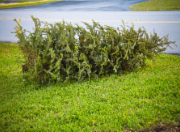South Florida’s weather and residential communities do not always mix well. It does not have to be a tropical storm or hurricane to cause a flooding issue. At any time of the year, a localized downpour from a severe thunderstorm has the potential to cause flooding. Anyone who has experienced these intense rainfall events understands that it only takes a small blockage in a storm drain or malfunctioning control structure to jeopardize the safety and wellbeing of the neighborhood.
The following is a good example of how rapidly the lack of maintenance can result in flooding. A few years ago, the southern portion of LWDD’s boundary experienced a severe and unexpected downpour. Around 1:00 in the morning, LWDD received a call from the President of a homeowner’s association. In a panicked voice he informed staff that flooding was eminent in his community. An LWDD employee was deployed. When he arrived on-site, he noticed there was no positive outflow from the stormwater pond to the drainage canal and it appeared there was an obstruction in the pond’s discharge control structure. Upon further investigation and after clearing 20-30 coconuts from the structure, he was able to provide enough flow of water to prevent a flooding incident. This is a true story but not a unique story.
Many residential communities have faced similar emergencies. It might not be coconuts from surrounding trees; but yard waste, debris, broken or unmaintained control structures and failed pipes can cause a similar crisis. Keeping the community’s drainage system and infrastructure in good working order year-round is a vital and necessary job for the community. You will want to ensure the discharge control structures, swales, storm drains, and outfall pipes have an unobstructed flow and are in good working order. In addition, proper landscape maintenance and removal of any encroachments on canal rights-of-way are imperative to avoid trees toppling over into canals as well as providing a clear path for large equipment should emergency access be required by LWDD crews.
The end of the 2023 storm season is near, but the end of storm readiness never ends.






